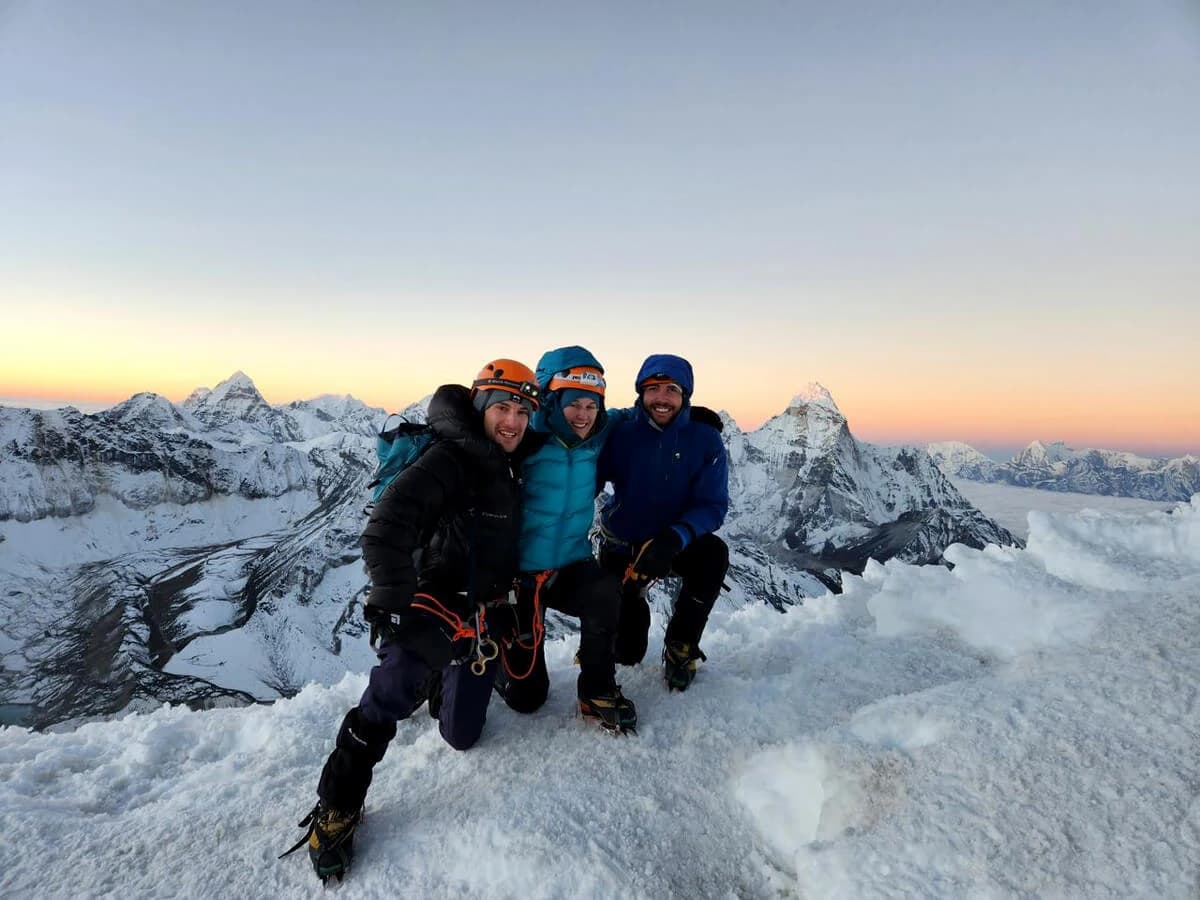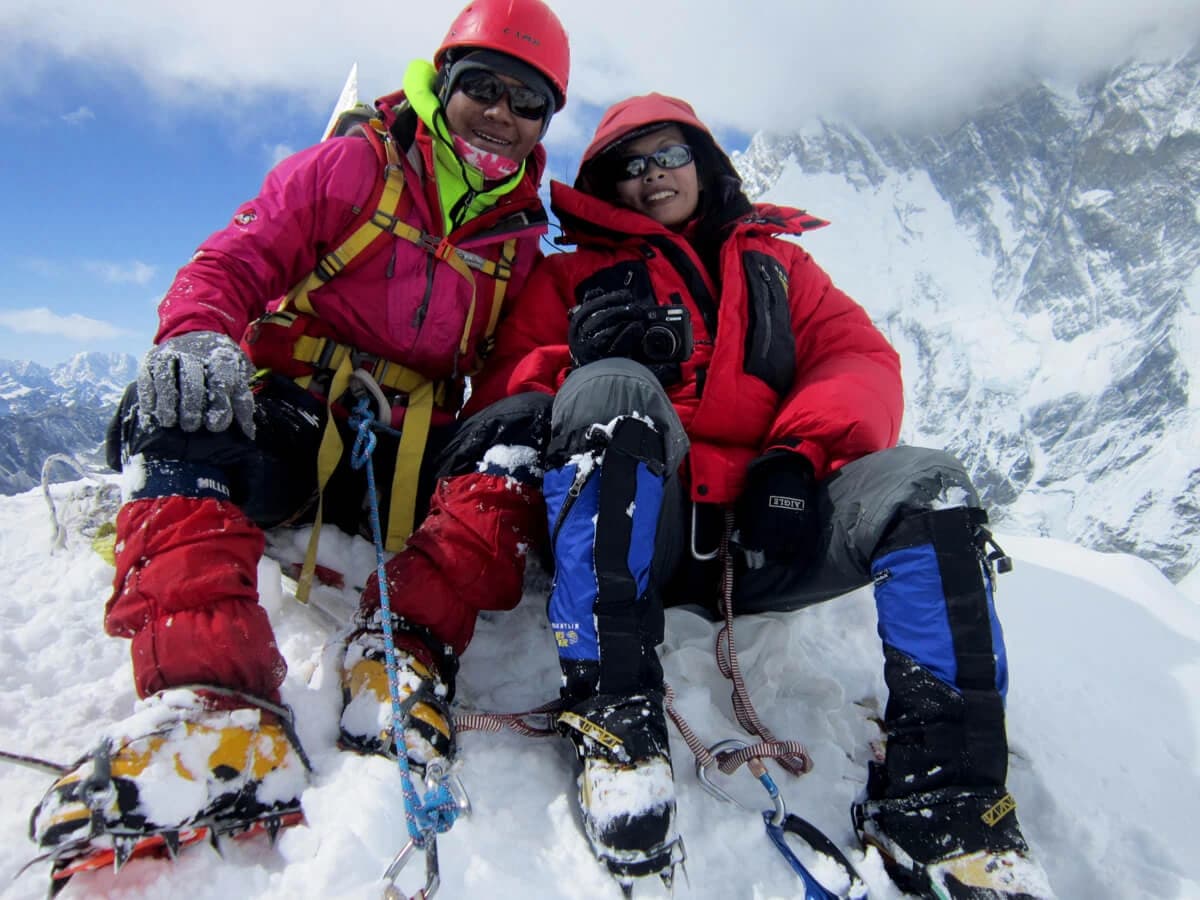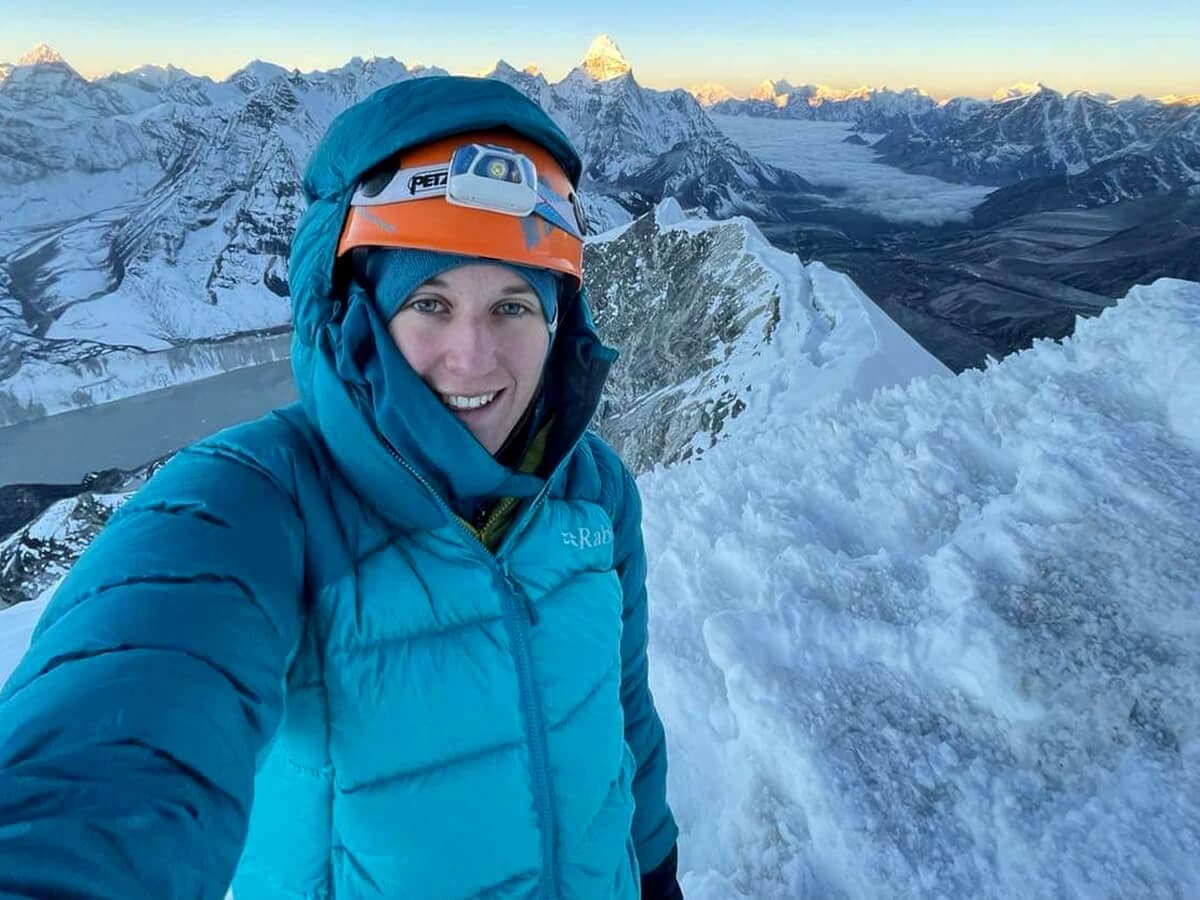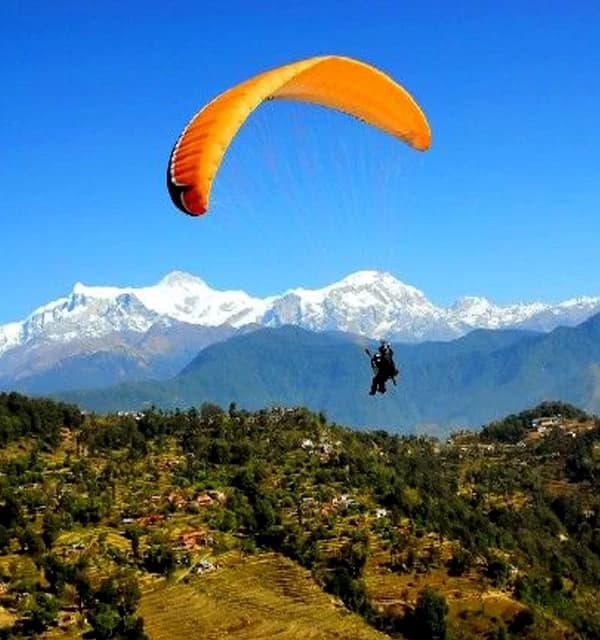Combining the Island Peak with the Everest Base Camp Trek creates a thrilling and fulfilling adventure, blending trekking and mountaineering in the heart of the Himalayas. This journey provides ample opportunities for acclimatization and exploration, allowing you to immerse yourself in the stunning landscapes of the Everest region.
Island Peak Climbing with Everest Base Camp Trek - 17 Days
Climbing Island Peak - The best beginner's peak!
Everest Base Camp Trek with climbing Island Peak, also known as Imja Tse, is one of the most popular trekking peaks in the Everest region of Nepal. Standing at an elevation of 6,189 meters (20,305 feet), it offers climbers a thrilling adventure that combines trekking through the stunning Khumbu Valley with the challenge of a high-altitude climb. The peak was named "Island Peak" by Eric Shipton's party in 1953 because it appears as an island in a sea of ice when viewed from Dingboche. The climb is technically straightforward, making it an ideal choice for those looking to gain experience in high-altitude mountaineering.
This comprehensive guide will cover everything you need to know about Island Peak climbing and the hike to Everest Base Camp, including the best time to climb, the necessary permits, the climbing route, the physical and technical requirements, and the equipment you'll need. We'll also discuss the cultural and natural highlights of the trek, as well as the environmental and ethical considerations that come with climbing in this fragile region.
Overview of Climbing the Island Peak and Everest Base Camp Trek
Location and Geography: Island Peak is located in the Sagarmatha National Park in the Khumbu region of Nepal. It is part of the Mahalangur Himal range and lies close to the base of the world's highest peak, Mount Everest. The peak is situated between the Lhotse and Imja glaciers, and its summit offers breathtaking views of some of the world's highest mountains, including Everest, Lhotse, Nuptse, and Ama Dablam.
The mountain's name, "Island Peak," is derived from its appearance when viewed from Dingboche, where it stands out as an island in a sea of ice. The Nepali name, Imja Tse, refers to the Imja River, which flows from the Imja Glacier at the base of the peak.
History of Climbing
Island Peak was first climbed in 1953 by a British expedition as part of their training for the ascent of Mount Everest. The team, led by Eric Shipton, included Tenzing Norgay, who would later become one of the first two people to summit Everest alongside Sir Edmund Hillary. Since then, Island Peak has become a popular destination for climbers seeking to gain experience in high-altitude mountaineering.
The peak's relatively low technical difficulty, combined with its stunning location in the Everest region, has made it a favorite among climbers. It is often climbed as part of a longer trek that includes visits to Everest Base Camp and other iconic locations in the Khumbu Valley.
Preparation for Climbing Island Peak
Physical Fitness and Training:
Climbing Island Peak requires a good level of physical fitness, as the trek to the base camp involves several days of hiking at high altitudes. Climbers should be prepared for long days of walking, often on steep and uneven terrain, with a heavy backpack. The climb itself involves some technical sections, including the use of crampons, ice axes, and fixed ropes, so prior experience with these skills is beneficial.
To prepare for the climb, it is recommended to engage in a regular training program that includes cardiovascular exercise, strength training, and hiking with a weighted pack. Climbers should also spend time at high altitudes before attempting the climb to acclimatize to the reduced oxygen levels.
Requirement of Island Peak Climbing Technical Skills:
While Island Peak is considered a non-technical climb, it does require some basic mountaineering skills. Climbers should be familiar with the use of crampons, ice axes, and fixed ropes, as well as basic rope techniques such as belaying and rappelling. It is also important to have a good understanding of glacier travel and crevasse rescue techniques, as the climb involves crossing the Imja Glacier.
For those without prior mountaineering experience, it is recommended to take a course in basic mountaineering skills before attempting the climb. Many trekking agencies in Nepal offer training courses that cover the necessary skills for climbing Island Peak.
Island Peak Climbing Permits and Regulations
Climbing Island Peak with the Everest Base Camp Trek requires several permits, including a Sagarmatha National Park entry permit, a TIMS (Trekkers' Information Management System) card, and a climbing permit from the Nepal Mountaineering Association (NMA). These permits can be obtained through a registered trekking agency in Nepal or directly from the relevant authorities in Kathmandu. At Wilderness Excrsion, we include these permits as part of the package in the cost.
It is important to note that climbing permits are only issued to those who are part of an organized expedition with a licensed guide. Solo climbing is not permitted on Island Peak, and all climbers must be accompanied by a certified guide.
Island Peak Climbing Route to its Base Camp:
The itinerary to Island Peak begins with a flight from Kathmandu to Lukla, a small town in the Khumbu region that serves as the gateway to the Everest region. From Lukla, the trek follows the classic Everest Base Camp route, passing through picturesque villages such as Namche Bazaar, Tengboche, and Dingboche. We reach the Everest Base Camp as part of our acclimatization process before climbing the ascent of Island Peak, as proper acclimatization is crucial.
The trek to Island Peak Base Camp typically takes around 12 to 14 days, depending on the acclimatization schedule and the pace of the group, but our itinerary is 17 days with a combination of the EBC (Everest Base Camp ) Trek and Island Peak. Along the way, climbers will have the opportunity to visit iconic landmarks such as the Tengboche Monastery, the Everest View Hotel, and the memorial stupas at Chukhung.
The final stretch of the trek to Island Peak Base Camp involves crossing the Imja Glacier and ascending to the high camp at around 5,600 meters (18,373 feet). The high camp is the starting point for the summit push and offers stunning views of the surrounding mountains.
Summit Day of The Island Peak
Summit day on Island Peak typically begins in the early hours of the morning, with climbers setting out from the high camp around 1-2 AM. The climb involves a steep ascent up a rocky ridge, followed by a traverse across a snowfield to the base of the headwall. The headwall is the most technical section of the climb, with a steep slope of around 40-45 degrees that requires the use of fixed ropes, crampons, and ice axes.
After ascending the headwall, climbers reach the summit ridge, which offers breathtaking views of the surrounding mountains, including Everest, Lhotse, and Ama Dablam. The final push to the summit involves a short but exposed traverse along the ridge, culminating in a small platform at the top.
The descent follows the same route back to the high camp, where climbers can rest and refuel before continuing down to Chukhung or Dingboche. The entire summit day typically takes around 10-12 hours, depending on the conditions and the pace of the group.
Cultural and Natural Highlights of Island Peak with Everest Base Camp
Sherpa Culture
The Khumbu region is home to the Sherpas, an ethnic group known for their mountaineering skills and hospitality. The trek to Island Peak offers a unique opportunity to experience Sherpa culture firsthand, with visits to traditional villages, monasteries, and tea houses along the way.
Namche Bazaar, the largest town in the Khumbu region, is a hub of Sherpa culture and commerce. The town is home to several museums, including the Sherpa Culture Museum and the Everest Photo Gallery, which offer insights into the history and traditions of the Sherpa people.
Tengboche Monastery, located at an elevation of 3,867 meters (12,687 feet), is one of the most important religious sites in the Khumbu region. The monastery is home to a community of Buddhist monks and offers stunning views of Everest, Ama Dablam, and other peaks.
Flora and Fauna
The Sagarmatha National Park, which encompasses the Khumbu region, is home to a diverse range of flora and fauna. The park's lower elevations are covered in dense forests of rhododendron, pine, and fir, while the higher elevations are characterized by alpine meadows and barren landscapes.
The park is home to several species of wildlife, including the Himalayan tahr, musk deer, and red panda. Birdwatchers will also find plenty to see, with species such as the Himalayan monal, snow pigeon, and blood pheasant commonly spotted in the area.
Scenic Views
One of the highlights of climbing Island Peak is the opportunity to take in the stunning scenery of the Khumbu region. The trek offers panoramic views of some of the world's highest mountains, including Everest, Lhotse, Nuptse, and Ama Dablam. The climb itself provides even more spectacular views, with the summit offering a 360-degree panorama of the surrounding peaks and glaciers.
Why is it important to hike to Everest Base Camp before climbing Island Peak?
Around 15–20% of climbers are forced to abandon their Island Peak expedition due to altitude sickness before the summit push. A highly effective way to reduce this risk is to trek to Everest Base Camp (EBC) first. Not only does this strengthen your fitness and acclimatization, but it also greatly increases your chances of a smooth and enjoyable climb without altitude-related problems.
For this reason, we at Wilderness Excursion have designed the climbing of Island Peak with the Everest Base Camp Trek itinerary, combining the best of both adventures.
That said, trekking to EBC is not strictly mandatory before attempting Island Peak (Imja Tse, 6,189 m)—especially if you are already well-acclimatized from other recent treks or climbs. However, most climbers choose to include EBC (or a similar trek) beforehand for a few important reasons:
Acclimatization:
- Island Peak is over 6,000 m (20,000 ft). Jumping straight to that altitude without gradual exposure would put you at very high risk of acute mountain sickness (AMS), HAPE, or HACE, which kills several trekkers and climbers every year.
- Trekking to EBC (5,364 m) or at least spending several days in the Khumbu at progressively higher altitudes (Namche, Dingboche, Chukhung), or alternatively, you can trek to Gokyo Valley and traverse Chola Pass allows your body to adapt gradually.
- Many standard Island Peak itineraries include the Everest Base Camp and Kala Patthar (5,545 m) hike as a way to “pre-acclimatize” before the climb.
- The best is that you can do this Peak with the Ultimate Everest (Three Passes) Trek.
Strength & Conditioning
- The trek is physically demanding — days of hiking up and down rugged trails at altitude.
- Trekking to Everest Base Camp first builds your endurance and gives you a better chance of success on the summit push.
Scenery & Experience
- Many climbers see Island Peak as an add-on to the classic EBC trek.
- By visiting EBC, Kala Patthar, and then heading to Island Peak, you maximize your time in the Khumbu and see some of the best views of Everest, Lhotse, Nuptse, and Ama Dablam.
Logistics & Itineraries
- Island Peak and Everest Camp are very close by, it is merely some 13 KM. So why don't to take advantage of hiking the world’s most popular trekking route?
- The infrastructure (lodges, acclimatization stops, guides) is already set up, making the logistics smoother for the Everest Base Camp Trek with Island Peak Climbing.
PS: It’s not mandatory to go to EBC before Island Peak. Some climbers skip EBC and follow a more direct acclimatization route (e.g., Lukla → Namche → Dingboche → Chukhung → Island Peak). But you still need at least 11 to 13 days of trekking before the climb for safe acclimatization.
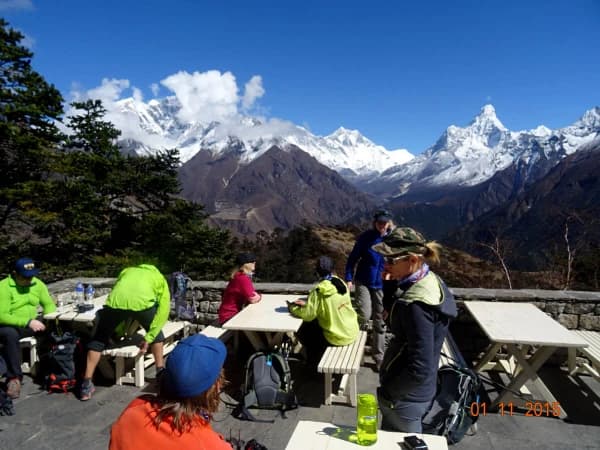
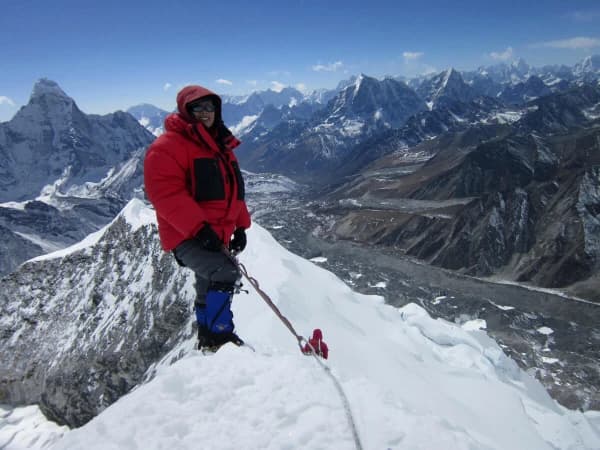
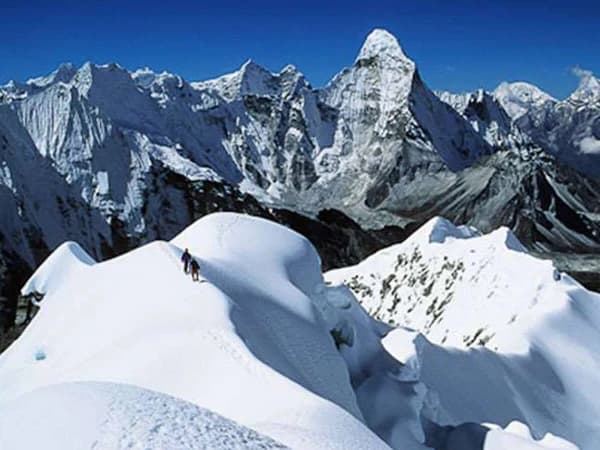
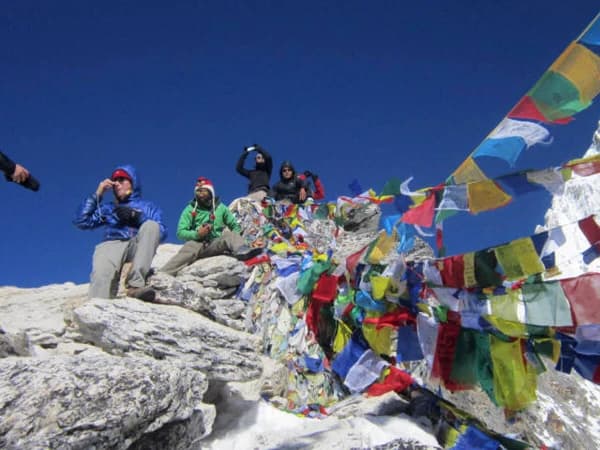
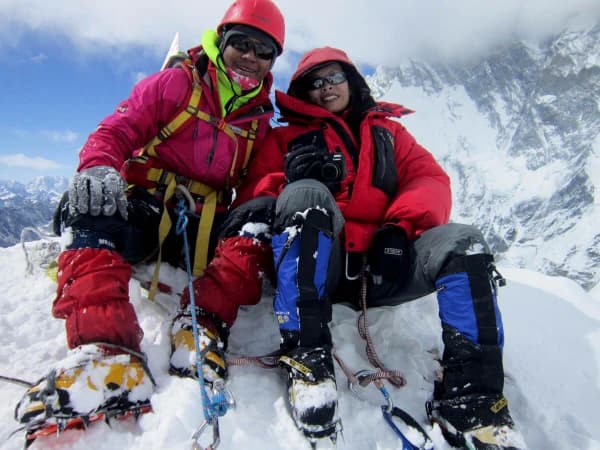
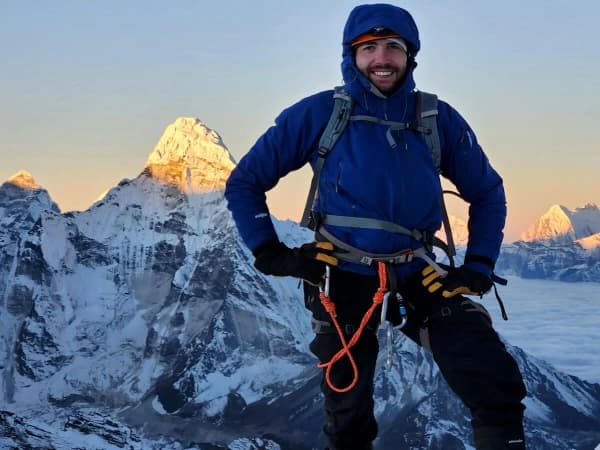
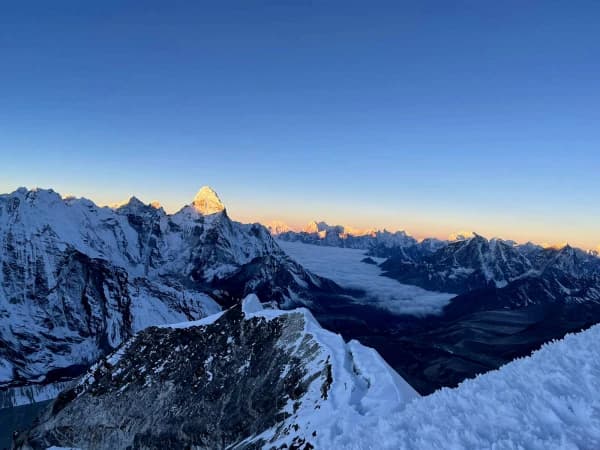

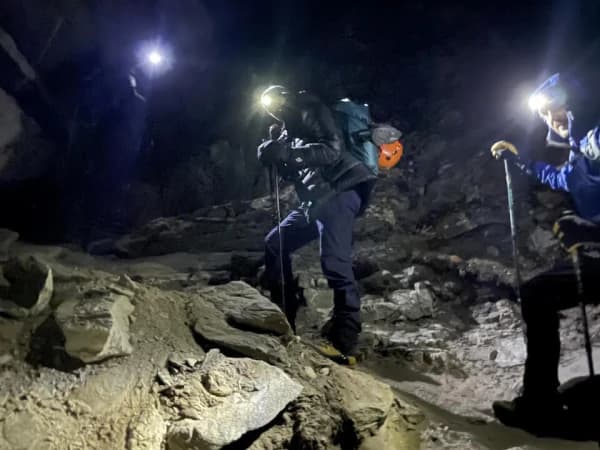
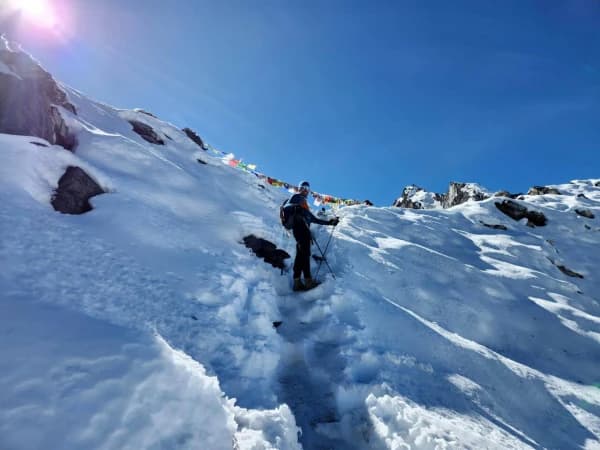
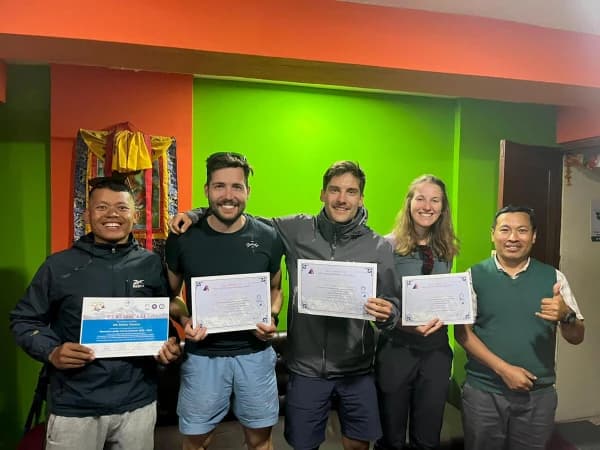
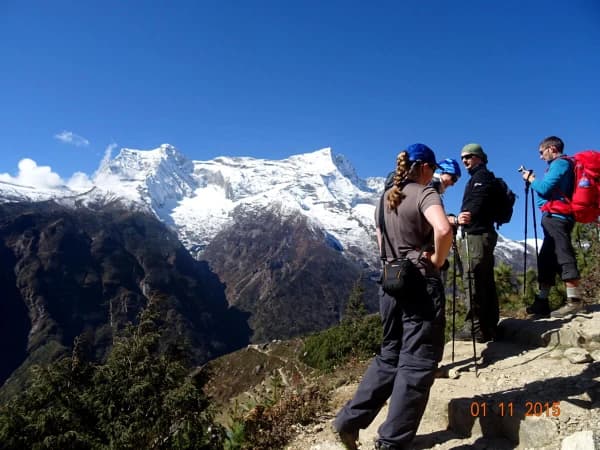
Following a satisfying breakfast, your tour guide will get you up from your Kathmandu lodging and drive you to Manthali in a private vehicle. The drive takes approximately 4 hours from Kathmandu city, which is 132 kilometers (82 miles) away, to the Manthali Town Airport. We travel along the recently constructed B.P. Highway leading to Dhulikhel town. From there, we continue our overland adventure to Manali town, which has a tiny airport. Spend the night at Manthali
Take an exhilarating morning flight to the world's most famous alpine airport, Lukla. Lukla, which was first planned by Sir Edmund Hillary's Himalayan Trust, is currently one of Nepal's busiest runways. As we fly, we witness the rough foothills give way to the Himalayan snowline. From the plane's windscreen, we can occasionally view many of the world's highest mountains, including Mount Everest (8,189m), Lhotse (8,516m), Gauri Shankar (7,145m), Menlungtse (7,181m), and Cho Oyu (8,153m). Your porters, who will carry your bags every day till you return to Lukla, will greet you after your thrilling landing in Lukla and give you a hearty welcome. Make time to acknowledge them and get to know them, even if it's just for a little while. We start our journey out of Lukla on the usually stony trail that descends from the city's forested terraces and directly enters the Dudh Kosi (river of milk) valley after stopping for a cup of tea to give the porters a chance to load up. Along the journey, you will encounter prayer wheels, mani stones, and big stones painted and carved with prayers—all of which are characteristic of the Buddhist nation of the Sherpa people. The trail also offers breathtaking views. These are considered sacred by Buddhists, and passing them in a clockwise manner is a sign of respect. We reach the small hamlet of Phadking, which is located directly next to the Dudh Kosi River, after going past the hamlets of Chaurikharka and Ghat finally we arrive at the thriving town of Phakding for an overnight stay
Today; we trek to Namche Bazaar, Sherpa capital, and heart of the Khumbu. You will now be becoming familiar with the local protocol for passing chortens, mani stones, yaks, and spinning prayer wheels and enjoying the hustle and bustle of trekking and everyday life that exists in Khumbu. Walking up the hill to Namche will be one of the harder days of the trek but we take it slowly (or the Nepalese word for slow is “bistarai”). Walking slowly at altitude is the key to acclimatization so this will become the norm for the trek. From Phakding it is about a 2 or 3-hour walk to Monjo, the trail follows the Dudh Kosi valley north, staying on its west bank and soon there is a good view of Thamserku (6,608m). After a walk uphill and over a ridge there is a traverse high above the river to Benkar, and a little further on you cross over a suspension bridge to the east bank of the Dudh Kosi to reach the small hamlet of Monjo at the entrance to the Sagarmatha (Everest) National Park. As you enter into Everest National Park area entry formalities have to be completed. We then follow the right bank of the river to where it starts to climb to the Hilary Bridge which is a tremendously impressive suspension bridge spanning a deep chasm. To reach Namche from here there is a long ascent a zig-zags up through the forest, but with a slow plod and several stops to catch our breath, we make our way steadily upward. Halfway up there is a viewpoint and cloud permitting should give us our first view of Everest appearing majestically behind the great ridge of Nuptse-Lhotse. We then pass through another entry point and as we traverse the hill we get our first views of the capital of the Khumbu- Namche Bazaar which is built on the steep sides of a sloping mountain bowl. It really is an impressive sight of colorful houses and lodges and prayer flags. Namche is a prosperous, busy, and vibrant Sherpa village as most treks pass through here.
Almost everyone heading to Everest Base Camp or doing any peak climbing expeditions group spends at least a day acclimatizing in Namche Bazaar the largest village in the entire Khumbu Region. We typically organize our Everest Base Camp Trek followed by Island Pak so that you can take a rest/acclimatization day in Namche and our guests usually hike up to the Everest View Hotel for a great panorama of the Himalayas which includes Everest, Ama Dablam, and Lhotse. While this is a great excursion, it’s good to know what the options are. If you’re trekking with us to Base Camp one of these sounds more appealing than the Everest View Hotel hike. To extend the day hike by a few hours; there are two beautiful Sherpa villages also known as “Twin Sherpa Villages” Khunjung and Khunde to visit and one can visit vibrant Buddhist monasteries and Khunde Health Post supported by Late. Sir Edmund Hillary’s Himalayan Trust. Walk back to Namche for an Overnight stay.
This morning after a short, steep climb we leave Namche on the classic approach route to Everest which contours the hillside high above the Imja Khosi. Today’s walk continues to contour the hillside with short steep sections as it crosses over ridges. There are spectacular views of Everest, Lhotse, and Nuptse and also the beautifully shaped Ama Dablam (6,812m). Ama Dablam means ‘Mothers necklace’, the long ridges on each side are like the arms of a mother protecting her child, and the hanging glacier is thought of as the Amdablam, the traditional double-pendant containing pictures of gods worn by Sherpa women. There is no doubt that the majestic Ama Dablam is one of the most beautiful mountains in the world. Passing by several villages and tea houses we will cross a tributary of the Dudh Kosi river on a suspension bridge at a place called Phunki Tenga before beginning a climb with a steep ascent for about two hours all the way up to the monastery. This part of the trek is forested by rhododendron and pine so it is well shaded and should be quite cool. The setting of Tengboche monastery is nothing short of magical and is a spectacular building and incredible to think that the temple was burnt down only a few years ago and rebuilt largely through the efforts of the Sir Edmund Hillary Trust. At 3 pm every day, the monks have their prayers and it is a special experience to watch this ceremony.
Today start our trek with an easy walk and descend through a forest of birch, fir, juniper, and rhododendrons coming to a lovely spot at Deboche 3,650m with magnificent views and the path is gradual up to the Pangboche village, from here onwards the lush vegetation and tree lines vanishes. Our further walk up to the ridge can be seen in the Pheriche Valley and continuing to descend to the river will reach Pheriche but this place is the most windy valley so we plan to stay in Dingboche.
Today we rest for acclimatization at Pheriche Valley, you may have a full day of rest or there are some places where you can hike for a day up to the Nagarjuna peak (5,050 m) from where you can see the breathtaking views of High Mountain including, Towering Mt. Lhotse, Amadablam, Mt. Makalu, Island peak and many more.
From Dingboche, we climb the ridge and cross the flat plain above the Pheriche valley. The trail leads to the bridge crossing a small stream immediately before the small hamlet of Dughla. From Dughla the trail climbs steeply onto the terminal moraine of the Khumbu glacier for a short section to Chukpo Lari, a beautiful, yet poignant place where there is a line of memorials in tribute to the climbers who have died on Everest. The panorama of all the peaks from this point is beautiful. From the memorial, the route descends a little and follows the western side of the valley to Lobuche. Lobuche is a cluster of lodges, teahouses, and shops and can be very busy. Taboche and Nuptse Peaks are particularly spectacular from Lobuche, towering almost two kilometers directly above you. Overnight at Lobuche. Meals included: Breakfast, Lunch, and Dinner)
It is challenging today but will no doubt be very rewarding and the highlight of the trek as you walk to Everest Base Camp. After an early start, we follow the undulating trail along the western side of the broad Khumbu valley and glacier. The views today are magnificent as you are totally surrounded by towering snowy peaks. The conical peak of Pumori soon comes into view, it is on a lower ridge of this mountain that we will be going to tomorrow morning for the Everest viewpoint of Kala Patar. After approximately 2 to 3 hours the trail descends onto a sandy basin to reach Gorakshep. After a light lunch, we will set off to walk to Everest Base Camp which is an approximately 5 to 6-hour return trek back to Gorakshep where we sleep tonight. After crossing the sandy flat at Gorak Shep the trail climbs onto the lateral moraine of the Khumbu glacier and ascends the side of the glacier for two hours before finally descending onto the rocky glacial moraine. The trail then winds up and down and through ice seracs to Everest Base Camp where there are fantastic close-up views of the Khumbu icefall. In spring season this Base Camp will be packed with many nationalities attempting to climb Everest. After a short stop, we will retrace our trail back to Gorakshep.
Our Guide will arrange a time for an early morning Kalapatthar excursion to start an early hike up to Kala Pathar for the most wonderful sunrise views of Everest. It takes about 2 hours to reach this hill top (the famous viewpoint). This small peak offers the best views of Mt. Everest, Nuptse, Pumori, and Ama Dablam along with the entire mountain views of Khumbu Himalayan range. Being here for some hours, we walk down to Gorekshep, have breakfast and continue to head down to Dingboche.
We have a very short day and after breakfast, we head further east side to 2-3 hrs gentle uphill to Chhukung, which is a hidden valley near the base of Island Peak. We'll have a full day of rest at Chhukung and the last place to prepare for camping and climbing gear.
Today, we head further on to the steep way climbing the southern part then turning east to the main line of the valley. Continue short pleasant walking along a streamside that leads to the big -rock. The route to the Amphu Lapcha lies to the southeast. A crisis cross route through the Imja and Lhotse glacier moraines leads to a wide valley flanking Island peak. We'll reach at Island Peak base camp and overnight at the tented camp.
Early morning through the rock gully we start our climb. This is not difficult but there are several short rock steps to climb before you emerge on the right side of the gully. The route follows a ridgeline, which leads to an exhilarating and exposed traverse onto the snout of the summit glacier. You will need to rope up for the glacier as it contains several crevasses but it leads without difficulty, to a 100m/330ft snow and ice slope (40-45 Degrees) on which the guides will fix a rope. From the top of this slope, 3 rope lengths along a sharp summit ridge lead to the top. You can enjoy with success and bravery to get a summit and after some picture taking of scenic view will descend to Chhukung for overnight at teahouse.
The walk today will be easy heading downhill to a lower elevation from Chhukung to Upper Pangboche and then we take a different route to Namche via Phortse Village. We see the towering majestic beautiful peaks of Amadablam and Kantega.
Trek down to Phungithanka a small settlement with a couple of teahouses with great memories after crossing the suspension bridge over the Dudh Koshi river trek onwards to the Mongla and re-track to Namche bazaar. The trail leads uphill through the forested path of silver fir, blue pines, rhododendrons, and some few magnolia and birch trees.
After a long trekking trip today we'll have a long and last day trek back to Lukla. We trek back with enjoying the lush green scenery around and passing through the incredible mountain scenery and local Sherpa village. After your arrival at Lukla you have time to stroll around the areas and guide will re-confirm your flight ticket and enjoy the last celebrate dinner with your crew member.
At around 08:00 AM fly back to Kathmandu our guide transfer you to your hotel. You may have time to relax after a long journey take back your breath and rest at your hotel by ending your Himalayan trip with us.
Lukla Flight Update: This alters on going to all Everest Treks and Climbing expeditions!
Because of high air traffic congestion in Kathmandu’s only airport that is for both international and domestic flights. CAAN (Civil Aviation Authority of Nepal) decided to continue the Lukla flight from Manthali in the Ramechhap district during the peak trekking season. This flight diverts has significantly altered the logistics for the Everest treks. To accommodate this change, we will have to adjust your departure schedule on the first day of your journey, our guide will pick you up from your accommodation around 1:00 to 2:00 AM and drive to Manthali (132 KM / 3 to 4 hours drive) to catch morning scenic flight to Lukla
A good option! Going to Manthali a day before your flight to Lukla for comfortable travel rather than rushing up. This just requires an extra day. Speak/write to your trip planner while booking.
- All domestic airport shuttles by private vehicle.
- A registered English-speaking trekking guide for 17 days.
- One shared porter between two trekkers.
- Climbing guide for Island Peak Expedition.
- Meals: 16 breakfasts, 17 lunches, and 16 dinners during the trip.
- Camping gear and other necessary logistics for Island Peak Climbing.
- Lukla round flight worth USD 450 per person.
- Flight fare of your guide and airport taxes.
- Trekking lodge accommodation during the trip on a twin-shared basis.
- Island Peak Climbing Royalty fees.
- Sagarmatha National Park entrance ticket.
- Guide and porter fee with all their expenses.
- Garbage deposit fee (nonrefundable)
- Taxes and documentation fees.
- International Airport transfers, accommodation and meals in Kathmandu
- Guided tours and heritage site entrance tickets in Kathmandu.
- Bar and beverages bills during the trek.
- Client's climbing gear (boots).
- Hot shower and hot water during the trekking
- Personal travel insurance, internet, phone calls, and laundry service.
- Rescue operation charge in case of emergency.
- Tipping guide and porters.
Check our published date! If it doesn’t match, we are happy to customize your tour perfectly to suit your interests and needs. Contact us for creating a unique travel experience for you
Environmental and Ethical Considerations
- Leave No Trace: Climbing in the Khumbu region comes with a responsibility to minimize the impact on the fragile environment. The Leave No Trace principles should be followed at all times, including packing out all trash, minimizing campfire impact, and respecting wildlife. Climbers should also be mindful of their water usage and avoid using single-use plastics. Many tea houses and lodges in the region now offer filtered water refill stations, reducing the need for bottled water.
- Supporting Local Communities: The Khumbu region relies heavily on tourism, and climbers can support the local economy by staying in locally-owned tea houses, hiring local guides and porters, and purchasing locally-made goods. It is also important to respect local customs and traditions, including dressing modestly and asking for permission before taking photographs of people or religious sites.
- Climate Change and Glacial Retreat: The Khumbu region is particularly vulnerable to the effects of climate change, with rising temperatures leading to the retreat of glaciers and the formation of glacial lakes. The Imja Glacier, which lies at the base of Island Peak, has been particularly affected, with the formation of the Imja Tsho glacial lake posing a risk of glacial lake outburst floods (GLOFs).
Climbers should be aware of the impact of their activities on the environment and take steps to minimize their carbon footprint. This includes choosing eco-friendly trekking agencies, using renewable energy sources, and supporting initiatives that aim to mitigate the effects of climate change in the region.
Equipment and Gear
Climbing Island Peak requires a range of personal gear, including clothing, footwear, and climbing equipment. The following is a list of essential items:
- Clothing: Layered clothing is essential for dealing with the varying temperatures and conditions on the climb. This includes base layers, insulating layers, and a waterproof and windproof outer shell. A down jacket is also recommended for the cold temperatures at high altitudes.
- Footwear: Sturdy trekking boots are essential for the trek to base camp, while mountaineering boots with crampon compatibility are required for the climb itself. Gaiters are also recommended to keep snow out of your boots.
- Climbing Equipment: Wilderness Excursion provides the necessary gear: crampons, an ice axe, a climbing harness, carabiners, and a belay device as part of our package. Climbers should bring their own climbing boots and personal clothing.
- Other Gear: A good-quality sleeping bag rated for cold temperatures, a sleeping pad, a headlamp with extra batteries, sunglasses with UV protection, and a water bottle or hydration system are also essential.
- Group Gear: Wilderness Excursion provides group gear, including tents, cooking utensils, and a first aid kit as part of our package.
Additional Tips and Recommendations for a Successful Expedition
- Acclimatization: Proper acclimatization is essential for a winning climb. It is suggested to spend at least two nights at Namche Bazaar (3,440 meters) and Dingboche (4,410 meters) to let your body adapt to the altitude. Taking rest days and ascending slowly can help prevent altitude mountain sickness (AMS).
Wilderness Excursion suggests you combine this expedition with the Everest Base Camp Trek and hike to Kalapatthar, which keeps you best acclimatized and makes you fitter to climb the Island Peak. Our carefully designed itinerary goes to Everest Base Camp and Kalapatthar first as a part of acclimatization.
- Stay hydrated and eat a nutritious meal: Staying hydrated and well-nourished is essential for maintaining energy levels and preventing altitude sickness. Drink plenty of water throughout the trek and climb, and eat a balanced diet that includes carbohydrates, proteins, and fats. High-energy snacks such as nuts, dried fruit, and chocolate can also be helpful.
- Weather Conditions: The weather in the Khumbu region can be unpredictable, with conditions changing rapidly. It is important to be prepared for a range of weather conditions, including cold temperatures, strong winds, and snow. Check the weather forecast regularly and be prepared to adjust your plans if necessary. Safety always comes always first!
- Mental Preparation: Climbing Island Peak is as much a mental challenge as it is a physical one. Be prepared for long days, challenging conditions, and the possibility of setbacks. Staying positive, focused, and determined will help you overcome any obstacles you encounter on the climb.
Final Thoughts
Island Peak climbing is an adventure that combines the thrill of high-altitude mountaineering with the beauty of the Everest region. With proper preparation, the right equipment, and a positive attitude, climbers can achieve their goal of reaching the summit and enjoy one of the most unforgettable experiences of their lives.
Whether you're drawn to the challenge of the climb, the stunning scenery, or the rich cultural heritage of the Khumbu region, Island Peak offers something for everyone. So, lace up your boots, pack your gear, and get ready for the adventure of a lifetime!
Island Peak, also known as Imja Tse, is located in the Everest region in Solokhumbu district, east of Nepal Himalaya. Island Peak, a popular trekking peak situated within Sagarmatha National Park, is near the Mount Everest Base Camp Trek route above Chhukung Valley. Specifically, it lies to the south of Mount Lhotse Shar and is considered an extension of its southeast ridge.
Yes, The Perfect Beginner-Friendly Climb in Nepal! Island Peak is one of the most accessible and beginner-friendly climbing peaks in Nepal! With the right mindset, proper preparation, and a spirit of adventure, summiting Island Peak is an achievable and rewarding challenge—even for first-time climbers.
Are you ready to push your limits and experience the thrill of high-altitude climbing? Start training, gather your gear, and prepare for an unforgettable Himalayan adventure!
The ascent of Island Peak (6,189 m) begins by following the classic Everest Base Camp trekking trail from Lukla, passing through Namche Bazaar, Tengboche, and Dingboche (4,410 m). From Dingboche, the route diverges southeast into the Chhukung Valley, leading to Island Peak Base Camp (5,200 m), situated south of Lhotse Shar.
For a more challenging and rewarding experience, many climbers combine Island Peak climbing with the Everest Three Passes Trek (Kongma La, Cho La, and Renjo La). This extended itinerary enhances fitness and acclimatization, significantly improving success rates on Island Peak’s summit.
The climb itself involves a steep snow/ice slope and a short technical section requiring fixed ropes, making prior high-altitude trekking experience beneficial. Proper acclimatization, physical preparation, and basic mountaineering skills are essential for a safe and successful summit attempt.
How long does it take to complete the climb of Island Peak?
The standard itinerary for climbing Island Peak (6,189m) typically includes the Everest Base Camp (EBC) trek as part of acclimatization, or followed by the Gokyo Valley extension, making the entire journey 15 to 17 days long.
However, experienced and fit climbers with prior high-altitude adaptation can opt for a direct ascent (without side treks), completing the climb in 10 to 12 days in total, starting from Kathmandu and ending in Kathmandu. This shorter option requires excellent physical conditioning and proper acclimatization to minimize the risk of altitude sickness. Contact your expert (Wilderness Excursion) for a perfectly tailored plan for your needs.
The cost of climbing Island Peak varies based on factors such as trip duration, climbing season, and the type of tour package chosen. On average, prices range from USD1500 to USD 2,200 per person, depending on the level of amenities and services included.
The success rate for summiting Island Peak (Imja Tse) typically ranges between 80% to 90%, depending on factors such as:
- Weather conditions (stable weather increases chances).
- Climber fitness and acclimatization (proper preparation is crucial).
- Experience of the guiding team (reputable operators improve odds).
- Season (spring and autumn have higher success rates).
While Island Peak is considered one of the more achievable trekking peaks in Nepal, proper preparation and favorable conditions play a key role in reaching the summit.
Preparing for the Island Peak (6,189m) climb requires physical and mental readiness. Start with cardio and strength training, focusing on endurance, leg strength, and core stability. Practice hiking with a weighted backpack to simulate trekking conditions. Acclimatization is crucial—spend time at high altitudes before the climb to avoid altitude sickness. Learn basic mountaineering skills like using crampons, ice axes, and fixed ropes. Pack essential gear: insulated clothing, a sturdy sleeping bag, climbing boots, and a harness. Stay hydrated and eat high-energy foods. Hiring an experienced guide ensures safety. Mental preparation is key—be ready for challenging terrain and unpredictable weather. Proper preparation ensures a successful summit.
From the summit of Island Peak (Imja Tse) in Nepal's Khumbu region, Mount Everest is visible on clear days, along with other towering peaks like Lhotse and Nuptse. While Lhotse may partially block Everest’s summit from certain angles, Island Peak still offers a breathtaking panoramic view of the Himalayas, including Everest.
Island Peak (Imja Tse) was first summited in 1953 by a British expedition team during their preparation for the Mount Everest ascent. Among the climbers were Tenzing Norgay, Charles Evans, Alfred Gregory, and Charles Wylie
Autumn and spring, the ideal seasons for climbing Island Peak, provide clearer skies and milder temperatures. With lower precipitation, conditions are safer and more favorable, while trails remain accessible and easier to navigate.
es, the Sherpa people refer to it as Imja Tse, which means "Island Peak." The name "Island Peak" was coined by British mountaineers, who were struck by how the summit appeared like an island amidst a vast sea of ice when viewed from Dingboche. However, the Sherpas have long known the mountain by its original name—Imja Tse. The word Imja refers to the valley where the peak is situated, while Tse simply means "peak" or "mountain
Island Peak, also known as Imja Tse, has a height of 20,305 feet and 6,189 in meters above sea level.
Island Peak (commonly known as Imja Tse) has a well-established Base Camp elevation of approximately 5,200 meters, which is about 17,060 feet above sea level.
I highly recommend Wilderness Excursion for an exceptional and well-organized adventure! My Island Peak Climbing experience was incredible—filled with fun, excitement, and professional support from start to finish.
The team provided invaluable practical climbing knowledge, thorough preparation (including acclimatization), and...
Climbing Island Peak was an incredible yet challenging experience, even though it’s often rated as a beginner-friendly trekking peak in Nepal. As someone with limited climbing experience—but a strong trekking and hiking background—I knew this would push my limits. Fulfilling...
I did the Everest Three Passes Trek and an Island Peak Climbing with my 3 friends. We had to skip the acclimatization day at Namche because of a flight cancelation from Kathmandu and had to go to Manthali for the...

